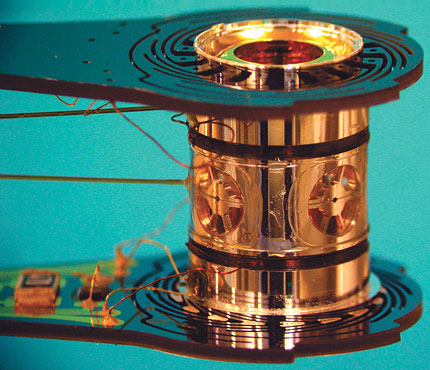Taking the next steps in fusion ignition quest
DOI: 10.1063/PT.3.2683
Although their initial campaign to achieve a sustained fusion reaction formally ended unsuccessfully more than two years ago, researchers at the National Ignition Facility (NIF) have continued to narrow the gap between best current results and their goal. Recent experiments have come within a factor of three of the parameter conditions—some combination of pressure, confinement time, and temperature, among other conditions—that are believed to be required for ignition, says John Edwards, the inertial confinement fusion program director at NIF host Lawrence Livermore National Laboratory. NIF’s initial result was within a factor of 10 when the first campaign ended in September 2012 (see Physics Today,June 2013, page 20
Now that they have significantly increased their understanding of the process of imploding the fusion fuel capsule, NIF scientists are turning their sights toward improving the performance of the hohlraum, the tiny (about 1 cm × 0.5 cm) cylinder surrounding the fuel capsule that converts the laser’s UV light to x rays that generate the implosion.

A hohlraum made from gold and 1 cm tall contains the fusion fuel capsule used in experiments at the National Ignition Facility. Light from the laser enters the ends of the cylinder and is converted to x rays, which implode the capsule.
LAWRENCE LIVERMORE NATIONAL LABORATORY

According to Edwards, if no further refinements were made in the quality of the implosions and the hohlraum performance scaled as expected, then achieving ignition would require two things: First, the NIF laser’s 1.8 MJ of energy would need to be increased threefold, and second, the target would have to be made twice as large. Edwards hastens to add, however, that no one is contemplating building such a mammoth laser, so performance gains will be needed in both capsules and hohlraums. The NIF capsules, about 2 mm in diameter, contain cryogenic deuterium and tritium.
Vacuums and gases
Researchers are exploring various hohlraum parameters to improve the spherical uniformity of the x rays that bathe and implode the capsule, to reduce harmful laser–plasma instabilities, and to improve the light-to-x-ray conversion efficiency. Options include changing the hohlraum’s shape, using different materials, and varying the gases and the pressures inside. Recent experiments show that near-vacuum conditions increase the conversion efficiency by roughly 50%, the equivalent of upping the laser’s maximum energy output by nearly 1 MJ, Edwards says. Removing gases also reduces the laser–plasma instabilities, which so far have prevented uniform x-ray deposition on capsules and produced high-energy electrons that can preheat the fuel and make compression more difficult.
But the downside of a vacuum is the likelihood of the hohlraum collapsing before the capsule can implode. Although the higher efficiency of the vacuum allows the use of larger hohlraums to delay the effect of the collapse, the improvement alone is insufficient for ignition conditions. Shortening the laser pulse to accelerate the implosion may fix the collapse problem, he says, but it will also decrease convergence, the degree to which the capsule is compressed. “We’re trying to find a parameter space where we don’t have these instabilities between the laser and the plasma happening and we’re able to get an acceptably round implosion at the convergence needed,” he says. “It’s a matter of experimentation and testing the ideas out and developing quantitative numerical models that match the experiments.”
Uranium and diamond
One idea is to change the shape by trimming off some of the cylinder’s length at the ends and widening it at the middle, so the hohlraum resembles a rugby ball. The scientists also want to test hohlraums that have interior walls of uranium rather than the gold that is normally used. Uranium has a better x-ray spectrum, with fewer x rays above 1.5 keV, which can penetrate the capsule and make it less stable. Multiple materials might be used to improve x-ray symmetry, and low-density foams also could be tried out.
To improve convergence with shorter laser pulses, researchers have been experimenting with capsules that have outer shells of diamond, three times as dense as the plastic that has been used. Initial results have been promising, Edwards says. With the higher density, the thickness of the outer shell can be reduced and the laser pulse shortened. Beryllium is another material being considered.
“Now we have a pulse that on paper we can put into one of these near-vacuum hohlraums and on paper we can implode [a capsule] spherically enough for ignition conditions,” says Edwards. “But we can’t yet believe a code to that level of accuracy.” Improving that quantitative understanding of target performance is a goal of the program.
If a candidate hohlraum–capsule system is identified, the challenge will then be to scale it down to work within the energy limits of the NIF laser, Edwards notes. Since operating the laser at full power stresses it, many experiments have to be conducted at about 80% of full strength. Only promising results will be tested at full power.
More about the Authors
David Kramer. dkramer@aip.org
